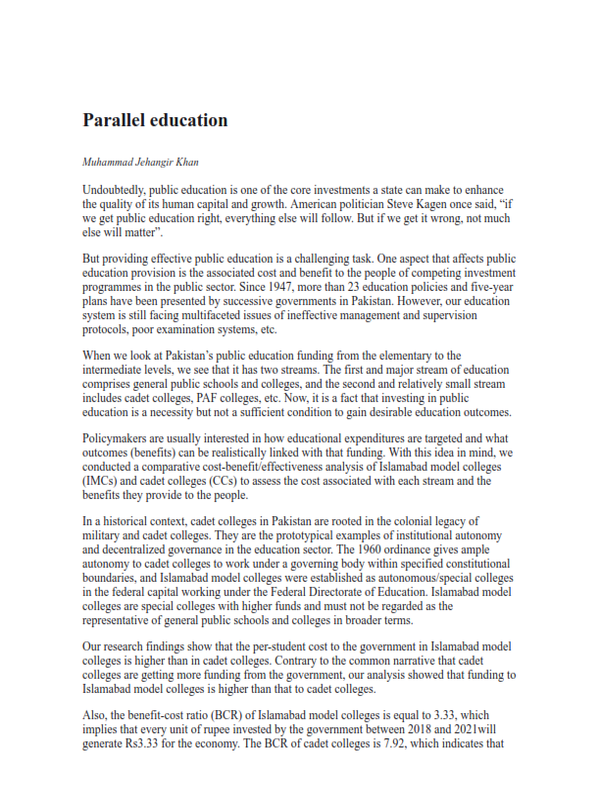
Pakistan Institute of Development Economics
- Home
Our Portals
MenuMenuMenuMenuMenuMenuMenu - ResearchMenuMenuMenuMenuMenuMenuMenu
- Discourse
- The PDR
- Our Researchers
- Academics
- Degree Verification
- Thesis Portal
- Our Portals
Parallel Education
Undoubtedly, public education is one of the core investments a state can make to enhance the quality of its human capital and growth. American politician Steve Kagen once said, “if we get public education right, everything else will follow. But if we get it wrong, not much else will matter”.
But providing effective public education is a challenging task. One aspect that affects public education provision is the associated cost and benefit to the people of competing investment programmes in the public sector. Since 1947, more than 23 education policies and five-year plans have been presented by successive governments in Pakistan. However, our education system is still facing multifaceted issues of ineffective management and supervision protocols, poor examination systems, etc.
When we look at Pakistan’s public education funding from the elementary to the intermediate levels, we see that it has two streams. The first and major stream of education comprises general public schools and colleges, and the second and relatively small stream includes cadet colleges, PAF colleges, etc. Now, it is a fact that investing in public education is a necessity but not a sufficient condition to gain desirable education outcomes.
Policymakers are usually interested in how educational expenditures are targeted and what outcomes (benefits) can be realistically linked with that funding. With this idea in mind, we conducted a comparative cost-benefit/effectiveness analysis of Islamabad model colleges (IMCs) and cadet colleges (CCs) to assess the cost associated with each stream and the benefits they provide to the people.
In a historical context, cadet colleges in Pakistan are rooted in the colonial legacy of military and cadet colleges. They are the prototypical examples of institutional autonomy and decentralized governance in the education sector. The 1960 ordinance gives ample autonomy to cadet colleges to work under a governing body within specified constitutional boundaries, and Islamabad model colleges were established as autonomous/special colleges in the federal capital working under the Federal Directorate of Education. Islamabad model colleges are special colleges with higher funds and must not be regarded as the representative of general public schools and colleges in broader terms.
Our research findings show that the per-student cost to the government in Islamabad model colleges is higher than in cadet colleges. Contrary to the common narrative that cadet colleges are getting more funding from the government, our analysis showed that funding to Islamabad model colleges is higher than that to cadet colleges.
Also, the benefit-cost ratio (BCR) of Islamabad model colleges is equal to 3.33, which implies that every unit of rupee invested by the government between 2018 and 2021will generate Rs3.33 for the economy. The BCR of cadet colleges is 7.92, which indicates that every unit of rupee invested by the government during the same period is expected to produce Rs7.92 for the economy in the long run.
It is important to note that for this particular cost-benefit analysis, we have relied on private benefits instead of social benefits, which implies that the benefits reported here might be understated. From a fiscal point of view, without considering the contributions of private and opportunity costs, the return on investment in cadet colleges is considerably higher as compared to the ROI in Islamabad model colleges.
Our findings also indicate that cadet colleges have 1.75 higher GPAs on average as compared to the Islamabad model colleges stream. This implies that the performance of cadet colleges is better in producing good academic scores as compared to Islamabad model colleges’. Therefore, it could be expected that cadet colleges are contributing more towards social wellbeing by producing higher academic grades as compared to Islamabad model colleges.
The writer is an assistant professor at the Pakistan Institute of Development Economics (PIDE) and can be reached at: [email protected]



